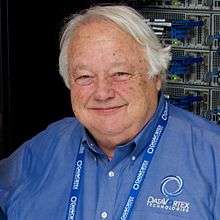Coke Reed
| Coke S. Reed | |
|---|---|
 Coke Reed in front of a Data Vortex Technologies DV206 Supercomputer | |
| Born |
Coke Stevenson Reed March 8, 1940 Texas, USA |
| Nationality | American |
| Known for | topology, dynamical systems |
Coke Stevenson Reed is an American mathematician and inventor from Austin, Texas. He is the inventor of the Data Vortex Supercomputer which uses a network topology and switch logic based on his and Krystyna Kuperberg's solution to a problem posed by Stan Ulam in the Scottish Book.
Coke completed his Ph.D. at the University of Texas at Austin under Hubert Stanley Wall.[1]
Biography
Dr. Coke Stevenson Reed is an American mathematician and the Inventor and Chairman of Data Vortex Technologies®, a privately-held US company composed of former members of the United States defense community.[2] In his work with the Department of Defense and Department of Energy, Dr. Reed developed a thorough understanding of the existing pitfalls of computer networks and performance. His career has included positions at the Institute for Defense Analyses, Los Alamos National Laboratories, the United States Space Program, and the Microelectronics and Computer Technology Corporation. Dr. Reed received his PhD in 1966 under Dr. Hubert S. Wall at the University of Texas at Austin.[3] His academic appointments have included the University of Texas, Auburn University, the University of Colorado Boulder, and Princeton University.
As a representative with the United States Department of Defense, Dr. Reed had a twenty-year relationship with the British Intelligence Community, actively participating in the UK-USA exchange. His contributions to national security were recognized in 1990 by the Department of Defense when he was awarded the Exceptionally Meritorious Civilian Service Award Medal.
Dr. Reed aims to break national security and big data analytics away from the confines of traditional computing with the creation and implementation of a revolutionary high performance computing network. Since 1995, he has authored thirty patents on the Data Vortex network.[4] Data Vortex systems have been placed in and are being shipped to leading American research institutions and organizations within the United States Government.